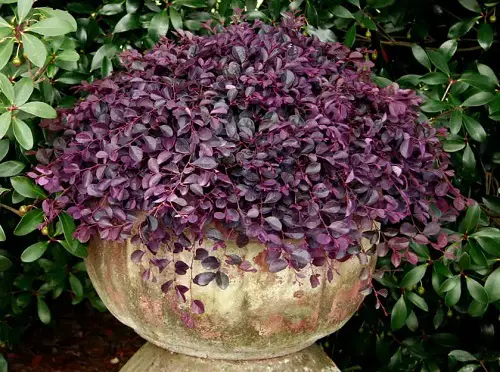Purple Diamond Loropetalum can be a beautiful ground cover, and you can also grow it in pots! Let’s have a look at the details!
Purple Diamond Loropetalum is a stunning plant with striking burgundy foliage and clusters of bright pink flowers. It’s a popular choice among gardeners who want to add color and texture to their landscapes.
Botanical Name: Loropetalum chinense ‘Purple Diamond’
USDA Zones: 9-11
Find When and How To Prune Loropetalum
Purple Diamond Loropetalum Information
Purple Diamond Loropetalum is a low-maintenance, fast-growing shrub that is native to China. It is a member of the Hamamelidaceae family and is related to Witch Hazel.
The shrub has deep purple, evergreen foliage and produces clusters of bright pink flowers in the spring. It is an attractive and versatile plant that can be used in hedges, accents, or as a foundation planting.
It grows best in full sun to partial shade and prefers moist, well-drained soil. It can reach heights of up to 6-8 feet and widths of up to 4-6 feet.
Propagating Purple Diamond Loropetalum
- Take 4-6 inches of cuttings in late summer or early fall when the shrub is actively growing. Snip them from the current season’s growth.
- Remove any flower buds from the cutting, and strip off the bottom leaves.
- Dip the cut end of the cutting in a rooting hormone and insert it into a moistened potting mix.
- Place the pot in a warm and bright location, and mist the soil daily.
- Once rooted, the cutting can be transplanted into its permanent location.
Requirements for Growing Purple Diamond Loropetalum
Sunlight
It requires full sun to partial shade to thrive. It can tolerate some shade, but too much shade can result in leggy growth and fewer flowers.
Plant it in a spot that receives at least 5-6 hours of sunlight per day. If you live in a hot climate, provide some afternoon shade to prevent the leaves from scorching.
Soil
The plant prefers well-draining soil that’s rich in organic matter. Purple Diamond Loropetalum doesn’t tolerate heavy clay soil, which can retain too much moisture and cause root rot.
If the growing medium is heavy, amend it with compost, sand, or perlite to improve drainage.
Watering
This plant requires consistent moisture but doesn’t tolerate standing water. Overwatering can lead to root rot, which can be fatal. On the other hand, underwatering can cause the leaves to dry out and drop.
Ensure that the soil is evenly moist but not waterlogged. Water the plant deeply when the topsoil feels a little dry to the touch.
During the winter, reduce watering, but don’t let the soil dry out completely.
Check out Texas Flowering Shrubs for the Garden
Purple Diamond Loropetalum Care
Fertilizer
Purple Diamond Loropetalum is a fast-growing plant that requires regular fertilization to keep it healthy and thriving. Fertilize your plant every six to eight weeks during the growing season (spring and summer) using a balanced liquid fertilizer.
Avoid fertilizing in the fall and winter when the plant is dormant. Overfertilization can cause excessive growth, which can weaken the plant and make it more susceptible to diseases.
Pruning
Pruning helps promote new growth, maintain a desirable shape, and prevent the plant from becoming leggy.
Prune your plant in late winter or early spring before new growth begins. Remove any dead, damaged, or diseased branches. You can also trim back the tips of the branches to promote bushier growth.
Pests and Diseases
Purple Diamond Loropetalum is relatively pest and disease-resistant. However, like all plants, it can be susceptible to certain pests and diseases.
Watch out for spider mites, aphids, and scale insects, which can suck the sap from the plant and weaken it. Treat these pests with insecticidal soap or neem oil.
This plant can also be affected by fungal diseases, such as leaf spots and powdery mildew. To prevent these diseases, avoid overhead watering, which can promote fungal growth. Remove any infected leaves and treat the plant with a fungicide if necessary.





